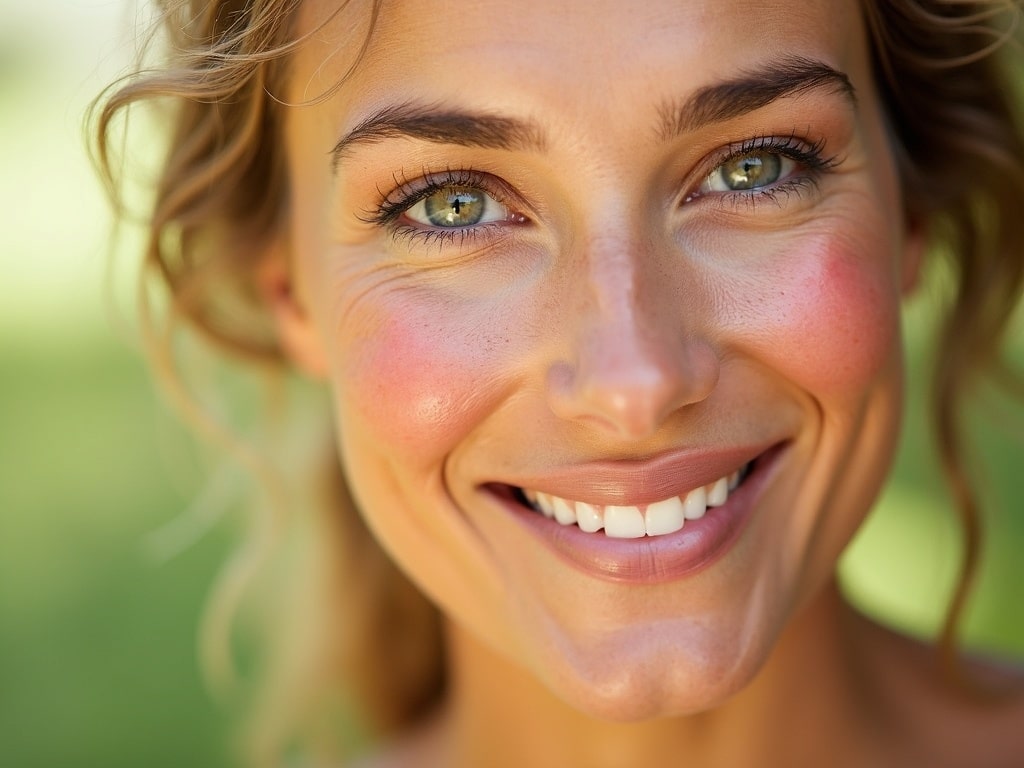Age spots, those small, darkened patches of skin, often feel like unwanted souvenirs from summers past. While they're typically harmless, many people find them cosmetically bothersome. But before you reach for expensive creams or harsh chemical treatments, consider this: nature may hold the key to fading those spots and reclaiming your youthful glow.
Natural Remedies for Age Spots: Unveiling Nature's Secrets for Radiant Skin
Understanding Age Spots: What Are They, Really?
Age spots, also known as liver spots or solar lentigines, are flat, brown, or black spots that appear on sun-exposed areas of the skin. Think face, hands, shoulders, and arms – the places that have seen the most sunshine over the years. Contrary to the outdated term liver spots, they have absolutely nothing to do with the liver. The real culprit? Overactive pigment cells.
These spots occur when melanocytes, the cells responsible for producing melanin (skin pigment), become hyperactive due to prolonged sun exposure. This overproduction of melanin clusters together, resulting in the visible dark spots. While sun exposure is the primary cause, genetics and the natural aging process can also play a role.
Differentiating Age Spots from Other Skin Conditions
It's crucial to distinguish age spots from other skin conditions like moles or skin cancer. Age spots are typically flat with defined edges. If you notice any spots that are raised, have irregular borders, are rapidly changing in size or color, or are itchy or bleeding, it's essential to consult a dermatologist to rule out any underlying health concerns. Early detection is key when it comes to skin health.
Nature's Arsenal: Top Natural Remedies for Fading Age Spots
Now for the good stuff! Here's a look at some effective, natural remedies that can help fade age spots and promote a more even skin tone:
1. Lemon Juice: The Citrus Brightener
Lemon juice is a classic home remedy for lightening skin discolorations, and for good reason. It’s packed with citric acid, a natural bleaching agent.
How to Use:
- Apply fresh lemon juice directly to the age spots using a cotton ball.
- Leave it on for 15-20 minutes.
- Rinse with cool water and moisturize.
- Repeat once or twice daily.
Important Note: Lemon juice can make your skin more sensitive to the sun, so always wear sunscreen after applying it.
2. Apple Cider Vinegar: The Alpha Hydroxy Acid (AHA) Powerhouse
Apple cider vinegar (ACV) contains alpha hydroxy acids (AHAs), which gently exfoliate the skin, helping to shed dead skin cells and fade dark spots. The acetic acid in ACV can also help to lighten pigmentation.
How to Use:
- Mix equal parts apple cider vinegar and water.
- Apply the mixture to the age spots with a cotton ball.
- Leave it on for 20-30 minutes.
- Rinse with cool water and moisturize.
- Repeat once or twice daily.
Tip: If you have sensitive skin, start with a more diluted solution (e.g., one part ACV to two parts water).
3. Aloe Vera: The Soothing Healer
Aloe vera is known for its skin-soothing and healing properties. It contains compounds that can help reduce inflammation and promote skin regeneration. While it might not be as potent as lemon juice or ACV, consistent use can contribute to a gradual lightening of age spots.
How to Use:
- Apply fresh aloe vera gel directly to the age spots.
- Leave it on for 30 minutes or even overnight.
- Rinse with cool water.
- Repeat daily.
4. Green Tea Extract: The Antioxidant Champion
Green tea is rich in antioxidants, particularly epigallocatechin gallate (EGCG), which can help protect the skin from sun damage and reduce the production of melanin. Applying green tea extract topically can help fade age spots and improve overall skin health.
How to Use:
- Steep a green tea bag in hot water for a few minutes.
- Let the tea cool completely.
- Soak a cotton ball in the tea and apply it to the age spots.
- Leave it on for 15-20 minutes.
- Rinse with cool water.
- Repeat once or twice daily.
You can also find creams and serums containing green tea extract.
5. Yogurt: The Lactic Acid Exfoliator
Yogurt contains lactic acid, another type of AHA that gently exfoliates the skin and helps to lighten age spots. It also contains probiotics, which can promote healthy skin bacteria.
How to Use:
- Apply plain, unsweetened yogurt to the age spots.
- Leave it on for 20-30 minutes.
- Rinse with cool water.
- Repeat daily.
6. Turmeric: The Anti-Inflammatory Brightener
Turmeric contains curcumin, a powerful antioxidant and anti-inflammatory compound that can help reduce hyperpigmentation and improve skin tone. It's often used in traditional medicine for its skin-brightening properties.
How to Use:
- Mix 1 teaspoon of turmeric powder with a little bit of water or plain yogurt to form a paste.
- Apply the paste to the age spots.
- Leave it on for 20-30 minutes.
- Rinse with cool water.
- Repeat 2-3 times a week.
Caution: Turmeric can stain the skin, so use it sparingly and be sure to rinse thoroughly.
7. Onion Juice: The Unexpected Remedy
While it might seem unusual, onion juice contains acids that can help exfoliate the skin and fade age spots. It’s a less common remedy, but some people swear by it.
How to Use:
- Grate an onion and squeeze out the juice.
- Apply the juice to the age spots with a cotton ball.
- Leave it on for 10-15 minutes.
- Rinse with cool water.
- Repeat daily.
The Power of Prevention: Shielding Your Skin from Future Damage
While these natural remedies can help fade existing age spots, prevention is always better than cure. Protecting your skin from sun damage is the most effective way to prevent new age spots from forming.
Sunscreen: Your Daily Shield
Make sunscreen your best friend. Apply a broad-spectrum sunscreen with an SPF of 30 or higher every day, even on cloudy days. Reapply every two hours, especially if you're swimming or sweating.
Protective Clothing: Cover Up!
Wear protective clothing, such as long-sleeved shirts, pants, and wide-brimmed hats, when you're spending time outdoors. Choose clothing made from tightly woven fabrics that offer better sun protection.
Seek Shade: Avoid Peak Sun Hours
Try to avoid prolonged sun exposure during peak hours, typically between 10 a.m. and 4 p.m., when the sun's rays are strongest.

Lifestyle Factors: Nourishing Your Skin from the Inside Out
What you put into your body also plays a significant role in your skin's health and appearance. A healthy diet and lifestyle can help protect your skin from sun damage and promote a more even skin tone.
Antioxidant-Rich Diet: Fueling Your Skin's Defense
Consume a diet rich in antioxidants, which help protect your skin from free radical damage. Include plenty of fruits, vegetables, and whole grains in your diet. Berries, leafy greens, and colorful vegetables like carrots and sweet potatoes are excellent sources of antioxidants.
Hydration: The Key to Supple Skin
Stay hydrated by drinking plenty of water throughout the day. Water helps keep your skin hydrated and plump, which can improve its overall appearance.
Limit Sugar and Processed Foods: Reducing Inflammation
Limit your intake of sugar and processed foods, as these can contribute to inflammation in the body, which can worsen skin conditions. Opt for whole, unprocessed foods whenever possible.
Patience and Consistency: The Keys to Success
It's important to remember that natural remedies typically take time to work. Be patient and consistent with your chosen method, and don't expect to see results overnight. Most natural remedies require several weeks or even months of regular use before you'll notice a significant difference.
When to See a Dermatologist: Seeking Professional Advice
While natural remedies can be effective for fading age spots, it's always a good idea to consult a dermatologist if you have any concerns about your skin. A dermatologist can accurately diagnose your skin condition and recommend the most appropriate treatment options. They can also rule out any underlying health concerns.
See a dermatologist if:
- You're unsure whether your spots are truly age spots.
- The spots are changing in size, shape, or color.
- The spots are itchy, bleeding, or painful.
- You have a family history of skin cancer.
- The natural remedies are not working after several months.
Embrace Your Skin's Journey
Age spots are a natural part of the aging process, and they're a testament to a life lived under the sun. While it's perfectly understandable to want to fade them, remember to embrace your skin's journey and appreciate the wisdom and experiences that come with age. Whether you choose to try natural remedies, seek professional treatments, or simply accept your age spots as they are, the most important thing is to feel confident and comfortable in your own skin. After all, true beauty shines from within, regardless of a few spots here and there.

